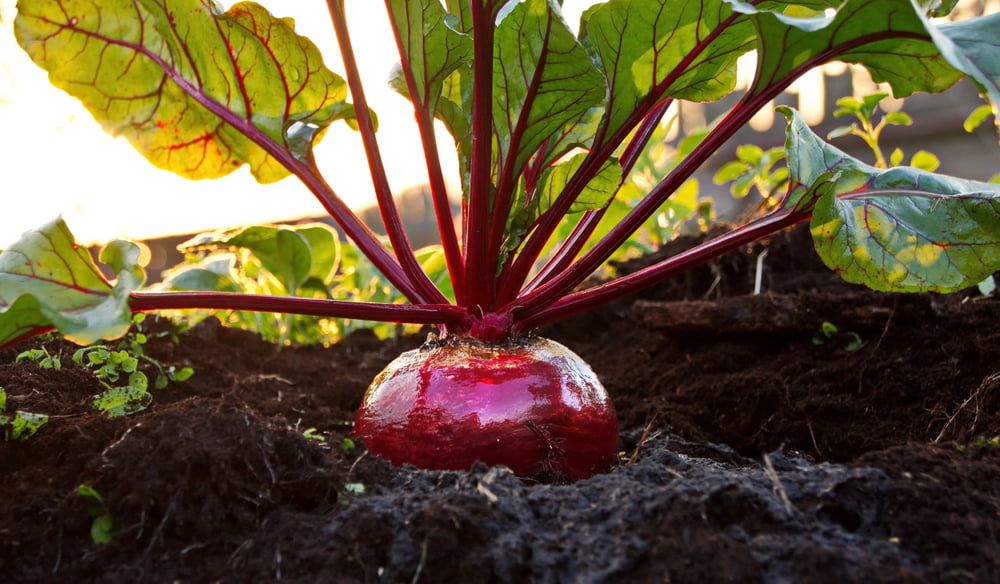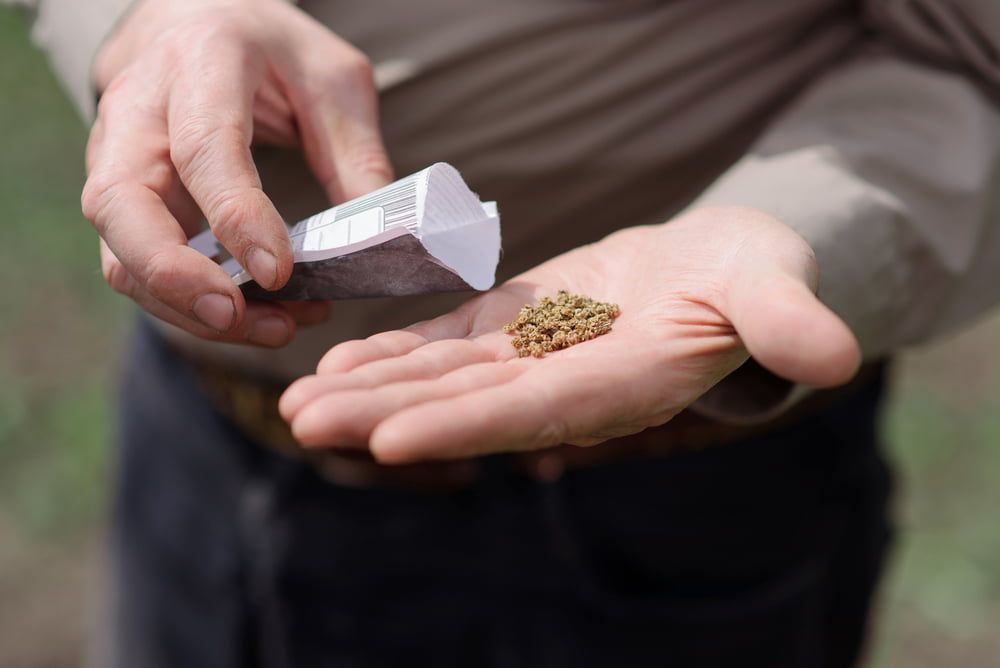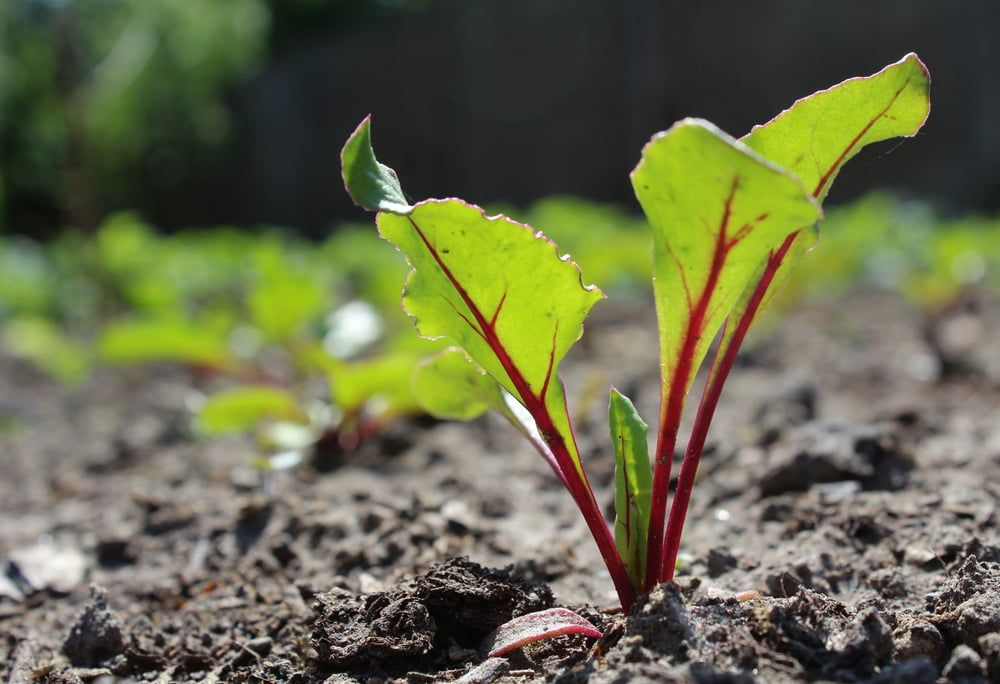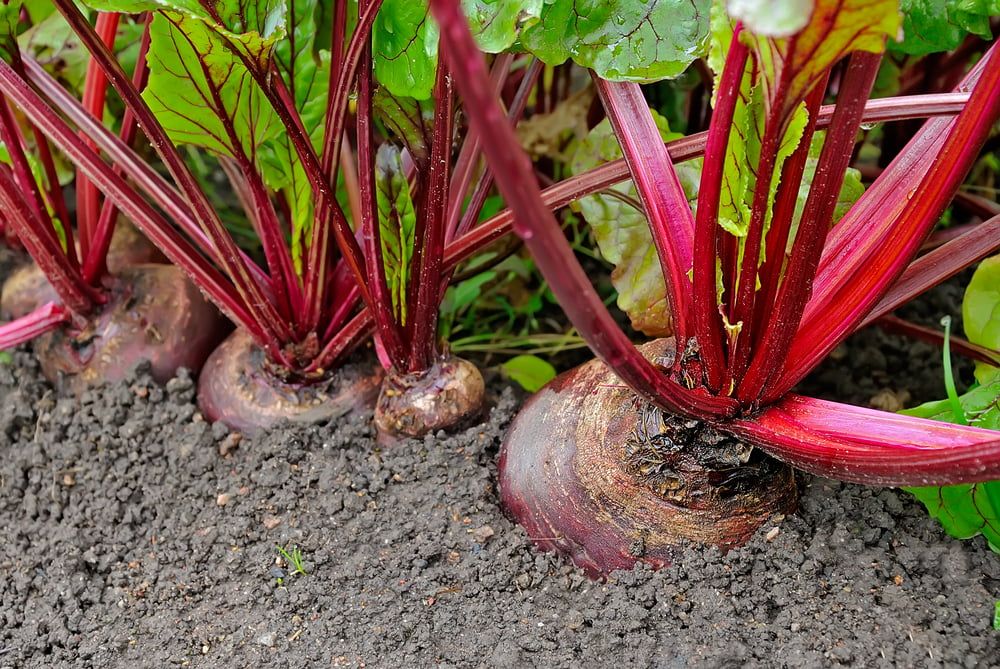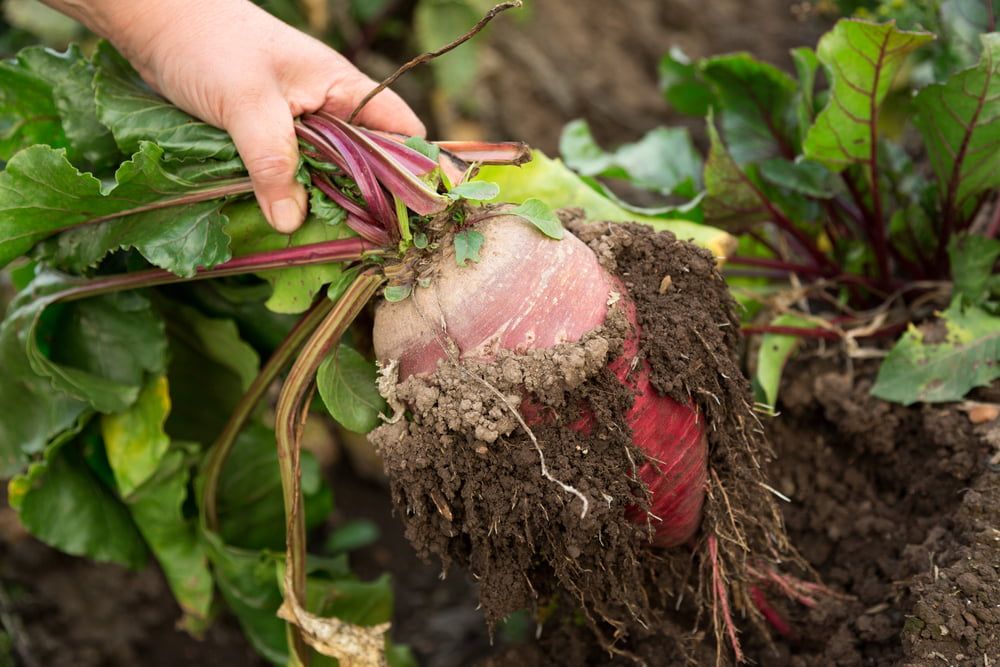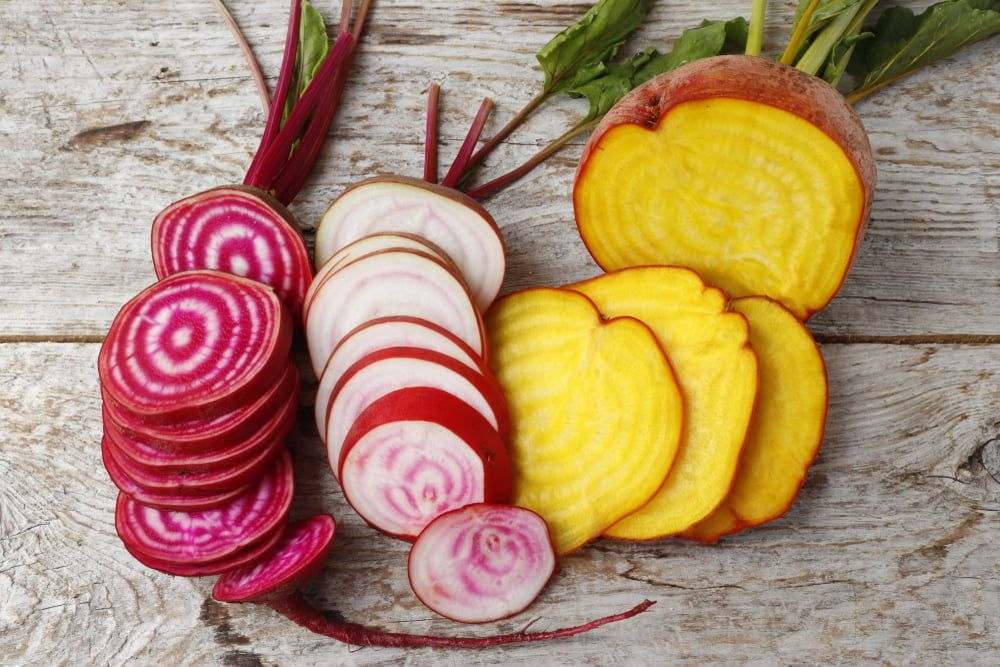
How to Grow Your Own Beetroot
Growing beetroot in the UK is straightforward and rewarding, as it’s a versatile root vegetable that can be used in salads, roasted, pickled, or even in baking.
Beetroot prefers cooler temperatures, making it an ideal crop for the UK climate.
Here’s a step-by-step guide to growing beetroot:
1. Choosing Varieties
- Select a variety that suits your taste and intended use. Popular choices include ‘Boltardy’, which is resistant to bolting, and ‘Chioggia’, known for its distinctive red and white striped flesh.
2. Timing
- Beetroot can be sown directly into the ground from March to July. For a continuous harvest, sow seeds every 2-4 weeks during the growing season.
3. Soil Preparation
- Beetroot prefers well-drained, fertile soil in a sunny position. Work in plenty of well-rotted garden compost or manure into the planting area a few weeks before sowing.
- Ensure the soil is free of large stones which could hinder root development.
4. Sowing Seeds
- Sow beetroot seeds 1cm deep, in rows 30cm apart. If your soil is heavy or wet, consider sowing into raised beds or large containers filled with a multi-purpose compost.
- Beetroot seeds are actually clusters of 2-4 seeds, so you’ll likely need to thin seedlings later.
5. Watering
- Water the ground gently after sowing and keep the soil moist, especially during dry spells. Consistent moisture is key to developing tender, flavorful roots.
6. Thinning Seedlings
- Once seedlings are about 2cm tall, thin them out to leave one seedling every 10cm. This gives the roots enough space to grow and develop.
7. Care During Growth
- Keep the beetroot patch free of weeds by gently hoeing or hand weeding, taking care not to damage the beetroot roots.
- Apply a mulch of garden compost or well-rotted manure around the plants to help retain moisture and suppress weeds.
8. Harvesting
- Beetroot can be harvested when they’re the size of a golf ball, about 90 days after sowing, depending on the variety. However, you can pick them at any size you prefer.
- Gently lift the beetroot from the ground using a fork, being careful not to damage the root.
9. Storing
- Beetroot can be stored in the refrigerator for several weeks, or they can be stored in boxes of damp sand in a cool, dark place over winter.
10. Succession Planting
- For a continuous supply, remember to sow a new batch of seeds every 2-4 weeks until mid-summer.
11. Pests and Diseases
- Beetroot is relatively trouble-free but watch out for leaf miners and the beetroot flea beetle. Practice crop rotation and use insect mesh to protect young plants if necessary.
12. Using Beetroot
- Beetroot is incredibly versatile. It can be eaten raw in salads, roasted, boiled, pickled, or even used in cakes for added moisture and natural sweetness.
Growing Beetroot: A Quick Snapshot
When to Sow – Feb-Aug
When to Plant – Mar-Sep
When to Harvest – Apr-Oct
Average Yield per Plant – 0.25kg
Spacing – 10cm
Depth – 2.5cm
How to Grow Beetroot at Home
Beetroot is a resilient and low-maintenance crop to grow. With lush green foliage contrasting with vivid red and purple roots, this plant also looks stunning in a vegetable garden.
Even better – if you sow some seeds every couple of weeks and then properly store your autumn harvests over the winter, you’ll be able to enjoy homegrown beetroot throughout the year.
Growing Requirements for Beetroot
One of the most tolerant of vegetables, beetroot will usually adapt to whatever growing conditions you provide.
That being said, your plants will do best if grown in full sun and a light, moisture-retentive soil. However, choose a location that provides some shade from the midday sun in mid-summer – too much heat will cause beetroot to bolt.
Being a cool-weather crop, beetroot is best sown in the spring and late summer. Daytime temperatures between 15-20°C will allow your plants to thrive.
How to Grow Beetroot from Seed
Unlike many other vegetable seeds, beetroot seeds are quite large, making them easy to plant. Each seed actually holds a cluster of smaller seeds, making it essential to thin out weaker seedlings further down the line.
Beetroot does well when direct sown. However, this can only be done in mid-March at the very earliest, meaning that you’ll need to wait until the end of spring for your first harvest. If you would like to start eating fresh beetroot a little earlier, start your first batch of seeds under cover in late February, before direct sowing from the end of March until August.
How to Sow Beetroot Seeds Under Cover:
- Fill modules or small pots with a multi-purpose compost
- Water well, ensuring that excess water is draining from the bottom of each module
- Make an indentation in each module, about 2.5cm deep
- Place two beetroot seeds into each indentation and then cover back over
- Water again, but lightly this time
While giving your beetroot seeds some heat will help to push germination on, the seeds will still sprout at temperatures as low as 7°C.
Seedlings will appear in about ten days. Give them a week or so to grow, before snipping away the weaker seedlings from each module.
Remember to keep your seedlings moist and well-lit until they are ready to be planted out.
How to Direct Sow Beetroot Seeds:
- After preparing your planting area, make furrows in the ground, about 2.5cm deep. Space each row 30cm apart
- Sow your beetroot seeds relatively thinly. Ultimately, you’ll be aiming for 10cm between each plant, but add a few extra seeds in as insurance
- Cover the seeds over with soil and then water well
Once your seeds germinate, give them a couple of weeks to grow before thinning them down, leaving 10cm between each plant.
Don’t forget that you can eat your thinnings!
How to Plant Beetroot Outside
It will take about a month before the seeds you sowed under cover are ready to move outside. Make sure that each plant has a few sets of true leaves before you plant them out.
Harden your plants off for a week or so, using this time to prepare your planting area.
Then, dig holes that are large enough to accommodate each beetroot plant, along with the soil that it’s growing in. Place your plants into their new homes before covering over and firming down. Then, water well.
How to Plant Beetroot in a Greenhouse
Although high temperatures will cause beetroot plants to bolt, a greenhouse is extremely useful for early and late harvests.
Simply prepare your greenhouse planting beds and then plant your beetroot in the same way that you would plant them outside.
If you don’t have any room in your greenhouse beds, beetroot grows well in a container too!
Look for round, rather than cylindrical, beetroot varieties, and make sure that your containers are at least 20cm in both diameter and depth.
The added benefit of growing beetroot in a container is that you can start your plants off in your greenhouse, before moving them outside once temperatures start to rise in the summer.
How to Care for Beetroot
Beetroot only requires the basics when it comes to care. Give your plants what they need and you’ll be enjoying your first harvest of baby beetroot in just two months time!
Watering Beetroot Plants
Beetroot plants need about 2.5cm of water a week. If rainfall is providing this, then you can sit back and relax. If not, then manual watering will be needed.
Don’t ever let your beetroot plants dry out. This will cause the roots to turn woody, making them split, which leaves them unpalatable.
Feeding Beetroot Plants
While most root crops don’t need to be fed, beetroot is a little different.
Your plants will really benefit from a high-nitrogen fertiliser applied soon after direct-sown seeds have germinated. If you’ve started your seeds under cover, fertilise them when planting them out.
Chicken manure pellets or a granular fish, bone, and, blood fertiliser work well when scattered over beetroot growing beds.
Weeding Beetroot Plants
Although you need to keep your beetroot plants weed-free, you also need to be careful not to damage the roots of your plants while weeding.
Ideally, try to weed around your plants as much as possible while they’re still young. Once they reach about 12cm in height, avoid disturbing the soil around your plants too much.
Mulching your beetroot plants once they are about 7cm in height will help to cut back on the amount of weeding you need to do. Grass cuttings and shredded leaves work especially well as a beetroot mulch.
How to Harvest Beetroot
Some beetroot varieties grow vigorously and are ready to be harvested at just 45 days, while others take a little longer, around 90 days.
Either way, you’ll know that your beetroot is ready to be harvested once the roots are somewhere between golf ball and tennis ball size.
Clear away some of the soil around the base of a stem to get an idea of how large that root is.
Once your beetroot has reached an ideal size, don’t be tempted to leave it in the ground for too long. This turns the roots tough, fibrous, and bitter.
To harvest a beetroot, place one hand around the base of the leaves and use your other hand to gently insert a hand fork into the soil just below the root. Slowly lever the fork to push the root up, while using your other hand to lift it out of the ground.
If your beetroot is refusing to budge, give your plants some water. This makes it easier to pull them out.
How to Store Beetroot
You’ve got a few options when it comes to storing your beetroot:
Storing Beetroot in the Fridge
Beetroot stored in the fridge will last for about one month.
All you need to do is chop off the tops (don’t forget that you can eat these – more on this later!) and then place your unwashed beetroot into a plastic bag. Remove excess air from the bag and then seal it up, before storing in the fridge.
Storing Beetroot in the Freezer
If you don’t have enough space for all of your beetroot in your fridge, or have harvested more than you could possibly eat in a month, then freezing is another option.
Unfortunately, raw beetroot doesn’t freeze well.
So, chop off the tops and boil the roots for about half an hour. Then, place them into an ice bath to cool, slide the skins off, and dice the roots up. Put them into an air-tight bag and then store in the freezer for up to one year.
Storing Beetroot in a Root Cellar
A cool and dark root cellar will keep your beetroot harvest fresh for up to three months.
Chop off the greens and then place the roots into a bucket filled with damp sand, making sure that the roots aren’t touching each other. Place a loose lid on the bucket to allow for ventilation, and check the roots regularly. If you notice that one is starting to rot, remove it immediately or it will cause the rest to start turning.
How to Prepare & Cook Beetroot
The first step to preparing your beetroot is chopping off the greens.
Don’t throw these out – they’re absolutely delicious! Use the greens in the same way that you would use spinach or kale.
The next step depends on how you plan on cooking the beetroot. You could either cut the roots into chunks to boil or steam, leave them whole to slow-roast, dice them up for a salad – the options are endless!
Whichever way you go, don’t be tempted to peel raw beetroot – it gets very messy! Instead, wait until they’re cooked and the skins will literally slide straight off.
If you’re needing some beetroot kitchen inspiration, some good dishes to try include:
- Balsamic roasted beetroot
- Beetroot salad with feta cheese, pear, and chorizo
- Beetroot soup
- Pickled beetroot
- Beetroot risotto
The vivid red hue of beetroot juice is also commonly used as a natural food dye. Simply add a small amount of the fresh juice to whatever requires a rosy tint.
Common Beetroot Problems
Beetroot plants don’t usually have many pests or diseases to deal with. This is one of the reasons why they’re considered to be such an easy plant to grow.
Birds pecking out young seedlings are sometimes an issue. However, this can be easily remedied by covering seedlings over until they’re a little larger.
Beet leaf miners may also make an appearance around your plants. These flies tunnel into leaves, causing affected parts to turn brown and dry up. Again, netting your plants will prevent these pests from accessing your beetroot, and small infestations can easily be manually picked off.
Popular Beetroot Varieties to Grow
Some forms of beetroot (sugar beet) are grown to make sugar, while others are grown for animal feed. The beetroot eaten as a vegetable is referred to as common beetroot, and all of the varieties that fall into this category can be split into two groups; rounded and elongated.
Here are some of the best of each to grow:
Best Rounded Beetroot Varieties:
- Boltardy
- Roja de Egipto
- Crimson King
- Monopoly
- Chioggia
Best Elongated Beetroot Varieties:
- Alto
- Larga de Covent Garden
- Cylindra
- Cheltenham
- Forono
Summary
There are so many different shapes, sizes, and colours of beetroot out there – something that you can really only truly appreciate once you start growing the vegetable yourself. The rich flavour and juicy texture of homegrown beetroot is so much better than anything that you could buy from a supermarket. Plus, the fact that growing your own means that you can enjoy your harvest throughout the year is an added bonus, especially in the bitter winter months!
